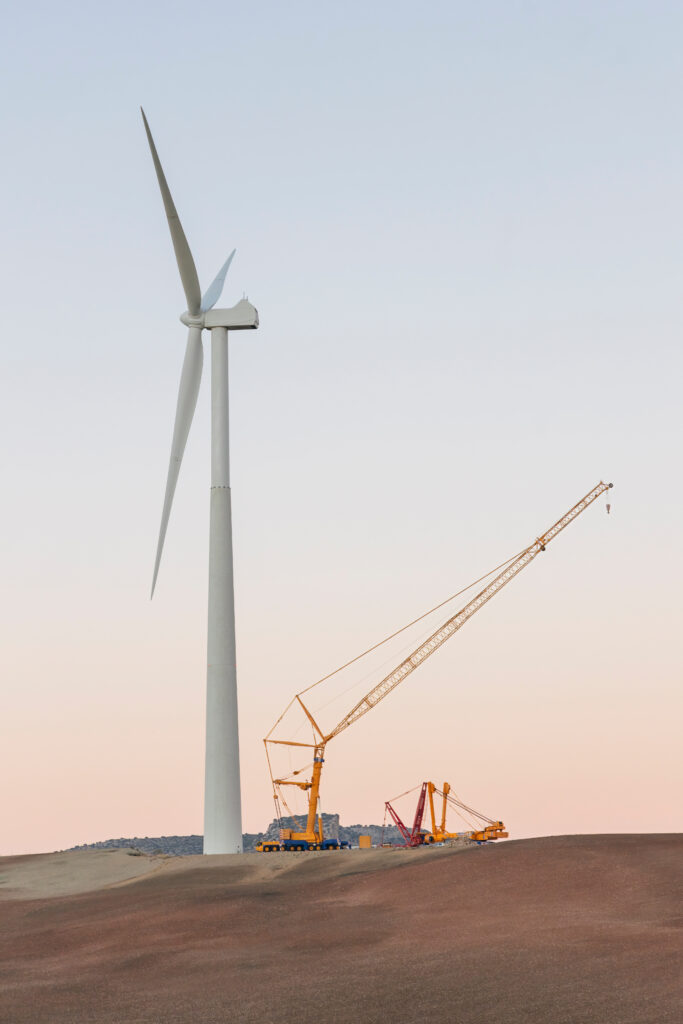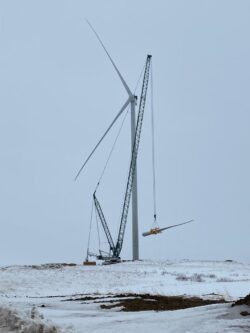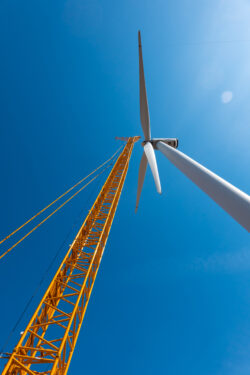
Features
Cranes
Projects & Infrastructure
Safety & Risk Management
Making safety a breeze
Contending with crane safety in wind farm construction
February 2, 2024 By Jack Burton
 (Photo credit: Adobe Stock)
(Photo credit: Adobe Stock) With nearly 6,700 turbines across 318 wind energy projects throughout the country, Canada knows how to build a wind farm, with cranes being a star of the show. Cranes play a key role in lifting each of these colossal structures to life and installing the turbines needed to meet Canada’s wind energy demands.
These demands are nothing to blow off: in the Canadian Wind Energy Association’s future strategy, the association outlined their goal of meeting 20 per cent of the country’s energy needs with wind power by 2025. This process, though, is not just about getting these wind farms up and running, but doing it in a way that’s both safe and efficient for all involved parties.
Amidst this push for alternative energy is the array of safety obstacles this specific type of construction work presents – high winds, extreme temperature exposures and a magnification of the risks around working at heights – and the challenges in managing them while still hitting deadline.
Weathering obstacles
“Operating cranes on wind farms introduces a host of unique challenges, with adverse weather conditions taking center stage,” said Joshua Kelly, general installation manager for Borea Construction, one of Canada’s leading wind farm contractors. “While engineers calculate wind speeds for each component and crane based on factors like wind coefficient, drag and surface area, decision-making for foremen and operators remains far from black and white.”
The intricacy of these safety decisions comes from the wide range of considerations that operators must remain mindful of, according to Kelly, including optimal tagline position and angles, crew training and competency, wind direction and overall workload and schedule.
“This complex interplay of variables demands a nuanced approach, where the expertise of the team is crucial in evaluating real-time conditions and making informed decisions to ensure safe and efficient lifting operations in the dynamic environment of wind farm construction,” Kelly said.
For Kelly, the goal of establishing a safe operating environment for cranes on wind farm projects is not accomplished by any one specific action, but a well-rounded combination of efforts ranging from a project’s equipment arsenal to its personnel’s education and training.
These practices include crane walks and rigging inspections to assess structural integrity and flag potential issues, the use of engineered crane pads to ensure load stability and prevent accidents, developing and following detailed lift plans for each step of the construction process and enhancing personnel knowledge across safety measures and decision-making through lift director training.

The propensity for extreme cold across Canada’s wind farm construction operations can lead to numerous safety hazards, including machine functionality, lubrication and flexibility. (Photo credit: Windcrane)
“These combined practices create a robust framework for crane safety, prioritizing both equipment reliability and the well-trained workforce essential for accident prevention,” Kelly said.
The need for crane safety precautions across wind farm operations becomes more pronounced across Canada’s environment, with the extreme cold and resulting frost conditions presenting a handful of unique occupational obstacles that require accommodation.
“Successfully navigating these challenges demands rigorous planning, adherence to safety protocols and specialized training for crane operators and construction crews working in these harsh winter conditions,” said Kelly.
“Hoar frost accumulation on crane components poses a significant hazard, impacting visibility and potentially compromising machinery functionality,” while “the freeze-thaw ground conditions characteristic of winter in Canada can create unstable surfaces, demanding extra caution to prevent accidents,” he said.
Proper maintenance is key to addressing these challenges, said Kelly, due to the effect that extreme cold can have on the crane’s mechanical components and lubricants, in addition to the low temperature’s impacts on the flexibility and strength of lifting slings and other types of rigging equipment.
Safety by numbers
With the high winds inherent to this work environment, its presence is completely out of the project’s hands. The risks these conditions present, and their significant ramifications on both worker safety and project costs, still demand adaptation and management from crane operators and project teams.
It’s in knowing and preparing for the precise wind velocity that separates a day of cautious work from a potential accident that operators can properly protect the health of both the project and the workers involved. The premise that data can equip crane operators and project leads to make these decisions with the necessary knowledge and intentionality is what Scottish company Windcrane has built its services on.
“Having the accurate form of data to help you decide between ‘yes, it’s safe’ and ‘it’s not safe, let’s wait’ is quite an important thing for the crane operator, and really for the whole site dealing with the operation,” said Melody Dewar, operations manager at Windcrane.
The company’s solutions have been used in the construction of numerous projects across both Canada and the world, including the Grizzly Bear Creek Wind Project east of Edmonton, Saint John, N.B.’s Burchill Wind Energy Project and the Jenner Wind Farm in southeastern Alberta.
Windcrane and its titular platform is in the business of helping contractors in the wind sector get their projects get built both safely and on time. The platform uses sensors implanted on the crane to not only measure real-time wind data, but also build a backlog of historical wind data over time that can measure and predict fluctuations in operational conditions.
“If you need to go back and check, then we will have provided a forecast from the heart of the crane,” said Dewar. “So from there, you can take all of that data and make a better decision now on what needs to do be done to perform your work safely and get the job done for the day.”

By providing wind speed data from the heart of the crane, Windcrane aims to help operators and project managers make the right decisions when it comes to safe operating conditions. (Photo credit: Adobe Stock)
While the intersection between data and wind power has always been at the core of Windcrane’s services, the company did not start out with crane operators as the target of their services. Rather, their technology was initially used to help companies scout potential wind farm sites; a process that demanded impeccable accuracy for proper energy output estimation.
“Years ago, we were measuring the wind speed in places where they were thinking of installing a wind farm,” said Eduardo Estelles, managing director and founder of Windcrane. Estelles explained that the wind energy industry requires very strict standards for calculating wind speed, as even a percentage of error in wind measurement could prove troublesome for an operation’s energy outputs over a 15-year timeline.
Changes in the wind farm sector pushed Windcrane to refocus their platform with the construction side of wind energy operations in mind, leveraging the value of the wind measurement accuracy the company developed across their technology toward ensuring safety for crane operators on these sites.
“With less and less onshore projects, and things moving more to offshore, we’ve reused that technology, moving away from measuring the possibility or viability of a wind farm, and toward measuring the safety of the person of the crane while they are erecting these things,” said Estelles.
Blowing through safety disputes
The solutions that Windcrane presents go beyond keeping crane operators safe; also allowing operators and the on-site team to accurately navigate the difficult gulf between working safely and dealing with project completion pressures.
Estelles explained that in most wind farm projects, “you have two teams almost competing against each other, both with very different priorities.”
On one hand, according to Estelles, are the crane operators and directors, for whom safety is paramount. In occasional opposition to this approach is the project manager or customer, who have a deadline to meet and may not be able to afford or manage the costs associated with weather-related delays in work.
“You can see already how that common goal of being very safe suddenly starts to have a bit of cracks,” he said. “Of course safety is number one, but at the same time, you have a ticking clock on your work at all times.”
With the potential for these disputes over safety versus productivity, the data provided by Windcrane’s platforms offer a way of mediating these interests. By offering accurate condition reporting, the platform helps crews navigate these issues by providing the clarity on when to move forward, and when a day off really could make the difference between life and death.
“Wind doesn’t go on and off, but more up and down – it’s a jump, like a wave of water,” said Estelles. “So if you get the forecast and see that it’s getting worse, and you look at the last few hours and see data to support that trend, it’s a clear indication that it will just be too risky to continue.”
Print this page